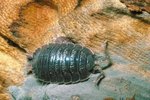
Both chiggers and bedbugs bite humans and leave red, itchy bumps on your skin, but that's about where the similarities end. The blood bedbugs suck out of you feeds their existence, while chiggers make a fatal mistake when they bite humans. The taxonomy, habitats, size and breeding habits of bed bugs and chiggers have stark differences.
Taxonomy
Larvae that pop out of eggs laid by a female mite of the Trombiculidae family are known as chiggers. They're the first life stage of adult mites in that family. While chiggers themselves are parasitic, the family of mites is not considered as such, because later forms have no parasitic qualities. Bedbugs come from the Cimicid family of insects. Bedbugs refer to the adult and nymph stages of the species. In both stages, bedbugs are parasitic.
Feeding
Chiggers require the tissue fluids of certain animals, such as birds, rodents and lizards, to provide them with nutrients so they can molt into nymphs and adults. Alabama Cooperative Extension System points out that nymphs and adults do not require hosts -- they eat insects and arthropod eggs. Despite their penchant for biting humans, chiggers would probably rather not do so. Because of the human body's response to chigger bites, the larvae typically die soon after latching on. Bedbugs are an entirely different story. Unlike chiggers, they require blood, rather than tissue fluids, to survive. According to the National Pest Management Association, bedbugs engorge themselves on human blood within 5 to 10 minutes -- chiggers take up to four days to engorge -- and then proceed to withdraw and hide for roughly 5 to 10 days. While bedbugs typically feast during the night when a person's sleeping, they can also come out and feed during the day.
Habitat
Chiggers prefer the great outdoors as their home. The tiny larvae hang out in thickets, open meadows and other areas in which tall grass and plants are present. They also enjoy dampness. These habitats conceal them perfectly, enabling them to latch onto the animals whose tissue fluids they require to survive. In contrast, bedbugs live indoors, typically in dark nooks and crannies and areas that place them close to their next meal. Examples include mattresses, box springs, bed frames, baseboards and even wallpaper.
Identification
Chiggers are tiny little things, to the tune of 1/150 of an inch in diameter and 1/50 of an inch in length. They're not invisible, but you typically won't see them in an overgrowth of grass and shrubs. Bedbugs aren't large by any means, but they're giants in comparison to chiggers, coming in at a quarter-inch in length. Chiggers take on a red color. Bed bugs look rusty brown with a slight tinge of red. Bed bugs are oval in shape, while chiggers largely resemble spiders. Both have six legs.
Reproduction
Chiggers, because they're larvae, do not reproduce. Once they molt into adults, males and females mate, the female lays eggs -- often in small clusters -- in the spring and chiggers hatch. Mating in bedbugs usually occurs after feeding. According to the New York State Integrated Pest Management Program, a female can lay five to seven eggs per week and up to 500 in her lifetime. The nymphs that hatch feed five times, molting after each meal into a larger, more mature stage. After the fifth molt, they become adults.
Prevention and Removal
Avoiding where chiggers tend to congregate -- tall grass, meadows, damp areas near rivers -- or wearing long pants and shirts if you do pass by those areas is the best way to prevent the parasites. The University of Missouri Extension suggests your mowing your grass regularly and trimming or removing shrubs and weeds. For bedbugs, keep your luggage and clothes on luggage racks and look in areas the insects commonly hide for evidence of an infestation when traveling. If they're present, you'll likely see their feces, which look like dark dots, or shell casings. Avoid purchasing second-hand furniture. If you notice an infestation in your home, call a pest control specialist.
References
- Alabama Cooperative Extension System: Chiggers
- University of Missouri Extension: Chiggers
- National Pest Management Association: Bed Bugs
- Pennsylvania State University College of Agricultural Sciences: Bed Bugs
- University of Kentucky College of Agriculture Cooperative Extension Service: Chiggers
- New York State Integrated Pest Management Program: FAQ List for Bed Bugs
Photo Credits
-
Jupiterimages/Brand X Pictures/Getty Images
Writer Bio
Located in Pittsburgh, Chris Miksen has been writing instructional articles on a wide range of topics for online publications since 2007. He currently owns and operates a vending business. Miksen has written a variety of technical and business articles throughout his writing career. He studied journalism at the Community College of Allegheny County.




